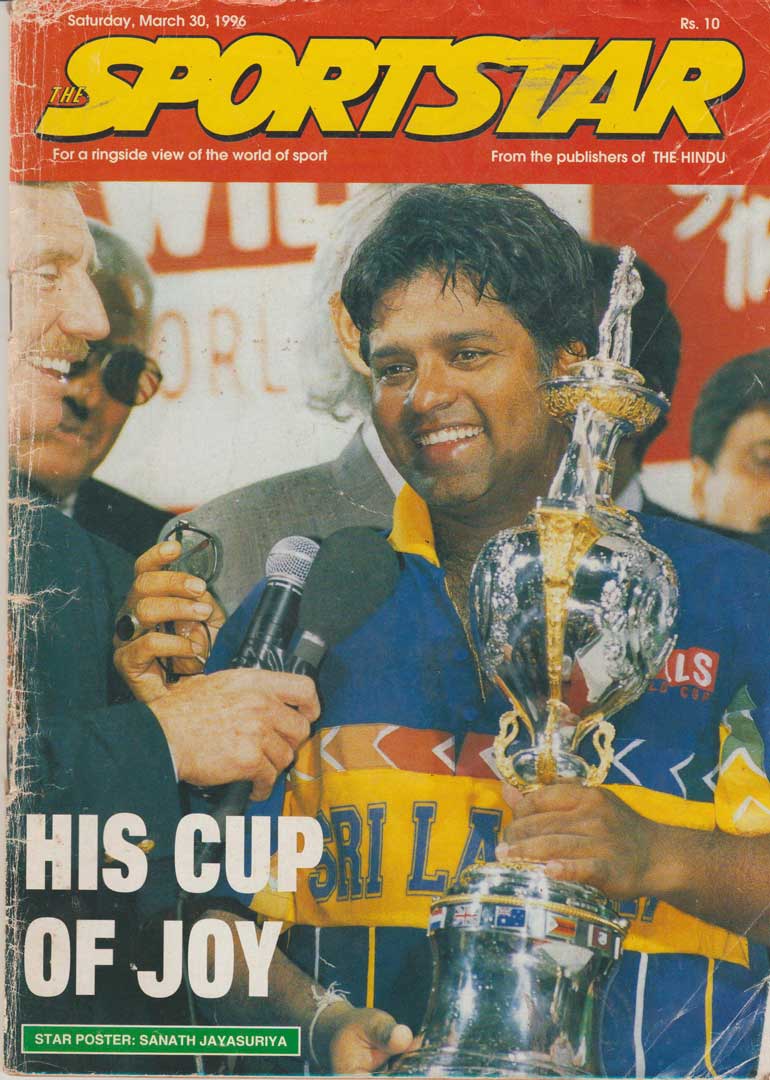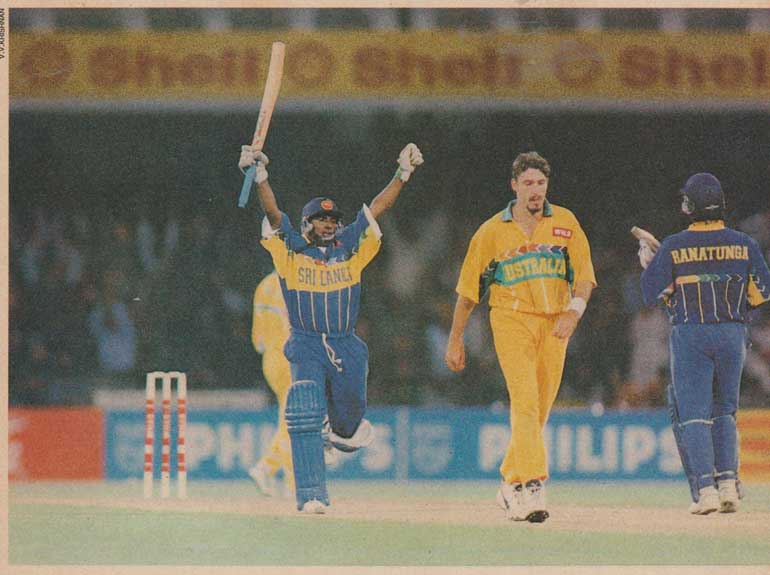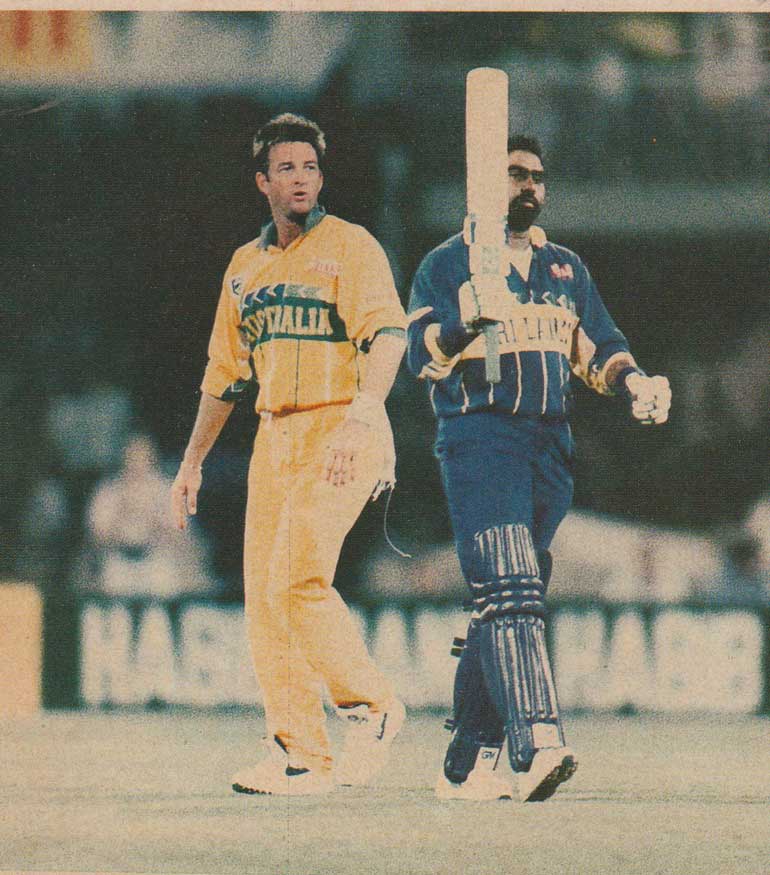Friday Nov 07, 2025
Friday Nov 07, 2025
Saturday, 12 March 2016 00:08 - - {{hitsCtrl.values.hits}}
 Jubilant skipper
Jubilant skipper

Aravinda de Silva celebrates his century

Asanka Gurusinha acknowledges cheers
“These Sri Lankans are giving the Aussies a hiding” – that’s what Tony Greig said on TV when Arjuna Ranatunga hit a Shane Warne full toss over the square-leg rope – a cricketing moment every Sri Lankan remembers. Sri Lanka was playing in the World Cup final at the Gaddafi Stadium in Lahore on 17 March 1996.
The winning runs were hit. For Tony G it was ‘a little fairy-tale’. “The thing I like about these guys is that they not only win, but they win in style. It’s only a small place, Sri Lanka, and what a moment this is for Sri Lanka people,” he said.
In five days the 20th anniversary of the landmark event in Sri Lanka’s cricket history will be celebrated. Ironically it comes at a time when the game is at a low ebb. On the very day next week Sri Lanka will meet West Indies in their opening game in the WorldT20 2016 in India.
Much has been written about the famous victory over the two decades. To mark the anniversary I hunted through my archives and picked a few comments made by cricket writers.
To cricket enthusiast/analyst/ anthropologist Michael Roberts, the team’s march to victory at the WC 1996 final was “a remarkable one, perhaps matchless”.
He writes in his ‘Forces & Strands in Sri Lanka’s Cricket History: “For one, virtually all their victories were comprehensive and the final triumph over Australia was comfortable. Secondly, batsmen from 8-11 only batted once during the whole series, while (Roshan) Mahanama at seven batted only thrice. Thirdly, they scored at 5.99 runs per over and 56.24 runs per wicket and bettered all previous rates on these scales. Fourthly, Aravinda de Silva secured four man-of-the-match awards, and Sanath Jayasuriya walked away with the award for ‘Player of the World Cup’ because his strike rate was 131.5 over 100 balls on top of his other specific contributions.”
Roberts listed out 10 ‘cricketing factors’ as the foundations for the emphatic march to victory:
The batting line up referred to by Roberts comprised of Sanath Jayasuriya, Romesh Kaluvitarana, Asanka Gurusinha, Aravinda de Silva, Arjuna Ranatunga, Hashan Tillkeratne and Roshan Mahanama. The bowlers were Chaminda Vaas, Promodaya Wickremasinghe, Muttiah Muralidharan and Kumar Dharmasena. In fact, the most successful bowler in the final game was Aravinda de Silva (3/42 in nine overs) who followed it up with a brilliant 107 not out. Giving him good support were Asanka (67) and Arjuna (47 not out). Sri Lanka won by seven wickets (245/3 in 46.2 overs) in reply to Australia’s 241/7 in 50 overs.
Calm and dignity
Commenting on Sri Lanka’s victory, England cricketer/commentator Mark Nicholas said that Sri Lanka deserved to win not just for quality of cricket but equally for “their calm and dignity in the face of endless provocation”.
He wrote in ‘The Cricketer’: “For a decade they had been a worthy team who needed exposure to the harsh world of international cricket but were too often denied it. For two months in Australia last winter they were subjected to allegations of ball tampering and throwing. On the eve of the tournament, the biggest draw cards, Australia and West Indies, withdrew from their preliminary round matches in Sri Lanka because of misgivings over security in the wake of a bomb that had exploded in Colombo 10 days before the Cup began. All the while they kept calm, making declarations of disappointment but never allowing the outside world to see the hurt. Never again need they be the whipping boys.”
Expressing his observations as a spectator in Lahore, Chandra Schafter, the well-known personality in cricketing circles, described how well Aravinda and Gurusinha rose to the occasion after Jayasuriya (9) and Kaluwitharana (6) departed early. “Gurusinha (65) though not quite batting true to form, nevertheless played an innings of great character and resolution. He scored whenever he could, so that it was indeed a tragedy that he got out before the end of the game. It would have been a fitting tribute to the contribution he has made to Sri Lanka cricket had he been there at the end.
“Aravinda played as he has never done before. We in Sri Lanka know him best as a swashbuckling knight in armour who knows only to attack despite the odds. On that day we saw a different Aravinda who demonstrated to all of us, as he has done once or twice before, that he is as much a master of defence as that of attack. It is this that sets him apart from his fellow cricketers…
“Finally I come to Arjuna who truly is the ‘warrior of the Mahabharatha’. Whenever his critics think it is time for him to go, they refer to his weight and to his rotundity. Arjuna could certainly do with a little less weight, but I wonder how many of his critics have heard of a gentleman named Colin Cowdrey who for a long time held the record for the largest number of slip catches in the world and has scored more Test runs than many of his colleagues…
“Arjuna had already done his job in the field by his wonderful captaincy and he continued to do so at the crease. The delectable cut he played off the first ball he faced was evidence of the greatness of the man. He played it so late that I wonder how many contemporary cricketers would even dare to try it. He continued to dominate the proceedings despite the presence of Aravinda. All of us who watched knew that it was Arjuna who was dictating the pace of the game, and how victory was to be attained. His treatment of Shane Warne whom he regarded as ‘a highly over-rated bowler’ gave proof of his ability not to be overawed by names and to play the bowling on its merits. Throughout his stay at the wicket he showed all of us that he is capable of making runs fast and that he is undoubtedly one of the finest ‘one-day’ batsmen in the world.”
(‘The Janashakthi Book of Sri Lanka Cricket,’ 1999)
Politics in cricket
At least one sports writer has not forgotten to record the role played by the then President of the Board of Control for Cricket in Sri Lanka (BCCSL), Ana Punchihewa whose strategic planning helped Sri Lanka to win the World Cup in 1996.
Asoka Goonetilleke in his recent publication ‘Palamuveniya’, describes how the Board members showed their ‘gratitude’ to Ana P after the World Cup victory. “The final was played on 17 February 1996. On 31 March he was thrown out at the Board elections. That day is recorded in history as the day when politics entered cricket elections. It was generally believed that Ana P would be elected uncontested. He himself believed that nothing untoward would happen. His erstwhile colleagues would be on his side. But he lost by three votes. His Vice President Upali Dharmadasa occupied the president’s chair. Several who had promised their vote to Ana P ultimately voted against him.”
Commenting on the ‘Post-1996 Consequences and Ramifications’, Michael Roberts wrote: “The finances of BCCSL expanded thousand-fold as a result of the World Cup victory. Cricket became big business within Sri Lanka and an attractive investment for sponsors. But these attractions and the existing constitutional scheme generated sharpening competition for posts, debilitating manipulations associated with a spoils system and organisational instability.”
The gusty bunch
‘Sportstar,’ the popular Indian cricket monthly, had Arjuna with the trophy on the cover page in March 1996 issue. Under ‘A spotless show,’ Sportstar said: “Even allowing for the fact that cricket may not be a truly world-level sport like football of tennis, Sri Lanka’s triumph in the Wills World Cup must surely be one of those extraordinary events in the world of sport – the sort of happening which is so wrapped up in emotion that it is going to take a long time to peel away the layers and understand its true significance.
“Now, less than a fortnight after the historic Lankan victory over Australia in Lahore, all we can say is that there cannot be a team that might be more deserving of such success than this gusty bunch of players from the emerald island who used adversity as a springboard for a famous victory in the premier one-day competition in the game.”